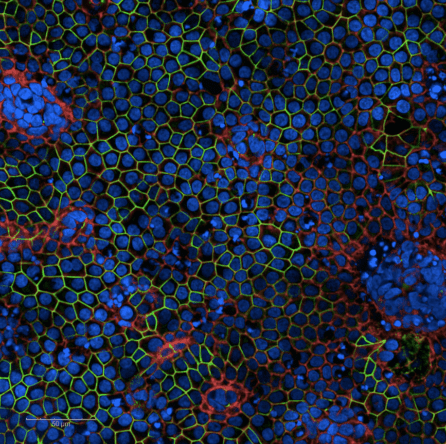NYSCF Advances Toward a Cell Therapy for Age-Related Macular Degeneration
The New York Stem Cell Foundation (NYSCF) today announced that they are developing a stem cell therapy to treat...
About AMD AMD News Publications FAQs Support AMD Research
At NYSCF, we are using stem cells to create retinal pigmented epithelial (RPE) cells from patients with age-related macular degeneration (AMD), giving us a living window into the causes of their deterioration. With more knowledge about what sparks the onset of the disease, we will be able to uncover new targets for therapeutic intervention, test drugs, and develop effective prevention strategies.
We are also building a diverse repository of stem-cell-derived RPE cells from AMD patients, allowing us to study how individual genetics influence the disease. In collaboration with the National Eye Institute at the National Institutes of Health, we are working to understand the genetic basis of AMD to help us predict who will get the disease and which drugs will work for which patients.

NYSCF is also using stem cells to develop a personalized cell replacement therapy with the potential to restore vision in patients with dry AMD. This therapy would directly replace the cells destroyed by the disease with healthy RPE cells created from the stem cells of patients. We are collaborating with top ophthalmological surgeons and scientists at Columbia University Medical Center to develop this therapy. We have now completed building the specialized manufacturing facility at our institute in which we will create clinical-grade RPE cells that are safe to transplant into patients.
A cell replacement approach to AMD has shown promise in previous clinical trials. In 2018, NYSCF – Robertson Stem Cell Prize Recipient Peter Coffey, DPhil, and his colleagues at University College London and the University of California, Santa Barbara found a way to surgically implant an ultra-thin patch containing non-diseased cells made from stem cells behind the eye’s rods and cones. When the patch integrates into the eye, the degenerating cells are replaced and lost function is restored. Two patients received the treatment in clinical trials, and both have experienced vision improvement.
Macular degeneration is one of the leading causes of blindness. It is a medical condition affecting the sensitive, central part of the retina – called the macula – in the eye. Macular degeneration patients lose retinal pigmented epithelial (RPE) cells in the macula, and when these cells begin to die, patients lose their central vision and can become blind. Because it develops with age, it is referred to as age-related macular degeneration, or AMD.
AMD affects 11 million people in the United States, and this number is expected to double by 2050. For those over the age of 75, the risk of developing AMD is nearly 30%
There are two major types of AMD: wet AMD and dry AMD. In wet AMD, abnormal blood vessels behind the macula break and bleed, damaging the macula and pulling it away from its base. Wet AMD accounts for roughly 10-15% of patients.
The causes of dry AMD, however, are not as well understood. Patients with dry AMD form deposits of drusen (yellowish, fatty proteins) beneath the macula, causing RPE cells to degenerate over time. Dry AMD accounts for roughly 80-90% of patients.
In both cases, RPE cells are damaged, leaving them unable to remove waste or feed nutrients to the eye’s rods and cones (cells that make vision possible).
AMD symptoms include distorted or blurry central vision, or loss of central vision. A common early sign of AMD is that straight lines will appear distorted.

The information provided is not medical advice and is not intended to be medical advice. If you are experiencing any of these symptoms, please talk to your doctor to determine the best course of action for your situation.
AMD usually affects older adults and is a leading cause of impaired vision in people over 50.
Risk factors for developing AMD include aging, family history of AMD, genetic predisposition, high blood pressure, high cholesterol, smoking, obesity, race, and exposure to sunlight, although they do not guarantee that one will get the disease.
While we know that the breaking of blood vessels behind the macula leads to wet AMD, the causes of dry AMD remain unknown.
Common AMD treatments include several approved drugs, vitamins, and lifestyle changes that can slow vision loss, but do not restore it. Patients with wet AMD may undergo periodic injections of a chemical called an “anti-VEGF” which helps prevent abnormal blood vessel growth and stop the bleeding which damages RPE cells.
The New York Stem Cell Foundation (NYSCF) today announced that they are developing a stem cell therapy to treat...
Age-related macular degeneration (AMD) is a leading cause of vision loss, and those over the age of 75 have...
The Context: Age-related macular degeneration (AMD) results from the death of retinal pigmented epithelial cells (RPEs) in the eye....
The Context: Age-related macular degeneration (AMD) is a disease which affects 8 million Americans and can lead to severe...
Below are select publications outlining recent advancements in AMD research from NYSCF scientists.
Altered transcriptome and disease-related phenotype emerge only after fibroblasts harvested from patients with age-related macular degeneration are differentiated into retinal pigment epithelium
Hui Cai, Jie Gong, NYSCF Global Stem Cell Array Team, Scott Noggle, Daniel Paull, Lawrence J. Rizzolo, Lucian V. Del Priore, Mark A. Fields. Experimental Eye Research. (June, 2021). DOI: doi.org/10.1016/j.exer.2021.108576
This study demonstrates an altered transcriptome and impaired mitochondrial function in RPE cells derived from AMD patients.
Stem cell‐derived retinal pigment epithelium from patients with age‐related macular degeneration exhibit reduced metabolism and matrix interactions
Jie Gong, Hui Cai, NYSCF Global Stem Cell Array Team, Scott Noggle, Daniel Paull, Lawrence J. Rizzolo, Lucian V. Del Priore, Mark A. Fields. Stem Cells Translational Medicine. 2019. DOI: 10.1002/sctm.19-0321.
A team of researchers including NYSCF scientists generated RPE cells from stem cells of patients with AMD as well as healthy controls and seeded these cells onto a substance designed to mimic an aged Bruch’s membrane, finding that the patient-derived cells recapitulated characteristics of AMD in this environment. The researchers also compared the patient-derived cells to healthy controls, finding that AMD-affected cells showed reduced metabolism.
High-throughput screening identifies compounds that protect RPE cells from physiological stressors present in AMD
Cai H, Gong J, Abriola L, Hoyer D, Stem Cell Array Team NG, Noggle S, Paull D, Del Priore LV, Fields MA. Experimental Eye Research. 2019 Apr 10. DOI: 10.1016/j.exer.2019.04.009
By testing over 5,000 drugs in human eye cells, a team of researchers including NYSCF scientists identified a compound which could protect RPE cells from disease-related stressors.
Risk factors for developing AMD include aging, family history of AMD, genetic predisposition, high blood pressure, high cholesterol, smoking, obesity, race, and exposure to sunlight. There are certain genes that put one at a higher risk for developing AMD, but the exact causes of the disease remain unknown.
Risk factors for developing AMD include aging, family history of AMD, genetic predisposition, high blood pressure, high cholesterol, smoking, obesity, race, and exposure to sunlight. However, the exact causes of AMD remain unknown.
AMD usually affects older adults and is a leading cause of impaired vision in people over 50.
AMD symptoms include distorted or blurry central vision, difficulty reading, extra sensitivity to glare, or loss of central vision. A common early sign of AMD is that straight lines will appear distorted.
The information provided is not medical advice and is not intended to be medical advice. If you are experiencing any of these symptoms, please talk to your doctor to determine the best course of action for your situation.
According to a 2011 study by researchers at the University of Wisconsin School of Medicine and Public Health and the U.S. Centers for Disease Control and Prevention (CDC), approximately 6.5 percent of Americans age 40 and older have some degree of macular degeneration. AMD affects 11 million people in the United States, and this number is expected to double by 2050.
Stem cells allow us to create RPE cells from patients with AMD, giving us a living window into the causes of their deterioration. With more knowledge about what sparks the onset of the disease, we will be able to uncover new targets for therapeutic intervention, test drugs, and develop effective prevention strategies. Stem cells also allow us to create healthy, patient-specific RPE cells with the potential to integrate into the eye and restore vision — a goal for future therapies.